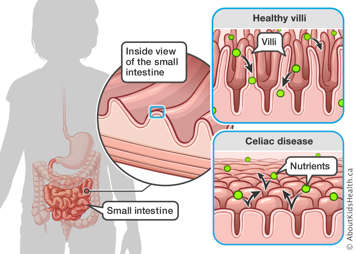Celiac disease is a disorder where the body’s immune system attacks itself. In celiac disease, the body develops sensitivity to gluten, the major protein of wheat, rye and barley. Celiac disease affects the ability of the small intestines to absorb food. Some people might have no symptoms, while others may experience belly pain, bloating, poor growth or weight gain, and loose, foul-smelling stools.

People with type 1 diabetes are at greater risk for celiac disease
People with type 1 diabetes have a greater chance to develop celiac disease. In people with type 1 diabetes, as many as 10% of children have celiac, compared with only 1% of children in the general population. Celiac disease can interfere with diabetes control. For example, children can experience:
- unexplained hypoglycemia (low blood glucose (sugar) levels)
- difficult blood sugar control.
Diagnosis of celiac disease
Routine screening for celiac disease in asymptomatic (not showing symptoms) individuals with type 1 diabetes is controversial. Untreated asymptomatic celiac disease is not associated with short or long-term health risks. However, if a person does have symptoms, screening by a blood test is recommended. If the blood test is positive, a biopsy of the intestines is done to confirm the diagnosis. This means a tiny piece of the intestine will be taken for further analysis. If someone else in your family has celiac disease, or you are worried that your child may have celiac disease, tell the diabetes team.
Treatment of celiac disease
Because the only treatment for celiac disease is a strictly gluten-free diet, you should work with your dietitian who will assess your meal planning and safely guide you through this process.